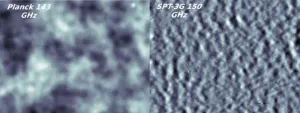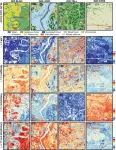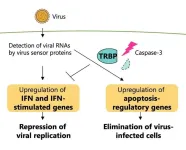(Press-News.org) Thanks to the dizzying growth of cosmic observations and measurement tools and some new advancements (primarily the “discovery” of what we call dark matter and dark energy) all against the backdrop of General Relativity, the early 2000s were a time when nothing seemed capable of challenging the advancement of our knowledge about the cosmos, its origins, and its future evolution.
Even though we were aware there was still much to uncover, the apparent agreement between our observations, calculations, and theoretical framework was indicating that our knowledge of the universe was set to grow significantly and without interruption.
However, thanks to increasingly sophisticated observations and calculations, the emergence of an apparently small “glitch” in our understanding of the Universe proved capable of jamming seemingly perfectly oiled gears. At first, it was thought it could be resolved it with even more precise calculations and measurements, but this was not the case. The "cosmological tension" (or Hubble Tension), is a discrepancy between the two ways in which we calculate the so-called Hubble parameter, H0, which describes the universe's expansion.
The Hubble parameter can be calculated following two paths:
The astrophysical observations of celestial bodies defined as local, i.e., not very far from us: it is possible to calculate the speed at which bodies at different distances are moving away. The expansion and H0 in this case is calculated by comparing speeds and distances.
The calculations based on data from the cosmic microwave background CMB, a faint and extremely distant radiation dating back to the very early Universe. The information we gather at that distance allows us to calculate the Universe's expansion rate and the Hubble parameter.
These two sources provided not exactly equal, but very close and consistent values of H0, and at the time it seemed that the two methods were showing good agreement. Bingo.
It was around 2013 when we realized that the "numbers didn't add up". “The discrepancy that emerged might seem small, but given that the error bars on both sides are becoming much smaller, this separation between the two measurements is becoming large”, Khalife explains. The initial two values of H0, in fact, were not too precise, and as the “error bars” were large enough to overlap, there was hope that future finer measurements would finally coincide. “Then the Planck experiment came along, giving very small error bars compared to the previous experiments” but still maintaining the discrepancy, dashing hopes for an easy resolution.
Planck was a satellite launched in space in 2007 to gather an image of the CMB as detailed as never before. Its results released a few years later confirmed the discrepancy was real and what was a moderate concern turned into a significant crisis. In short: the most recent and near sections of the universe we observe tell a different story, or rather seem to obey a different physics, than the oldest and most distant ones, a very unlikely possibility.
If it's not a problem of measurements then it could be a flaw in the theory, many thought. The current accepted theoretical model is called ΛCDM. ΛCDM is largely based on General Relativity - the most extraordinary, elegant, and repeatedly observationally confirmed theory about the universe formulated by Albert Einstein more than a century ago - and takes into account dark matter (interpreted as cold and slow-moving) and dark energy as a cosmological constant.
Over the last years, various alternative models or extensions to the ΛCDM model have been proposed, but so far, none have proven convincing (or sometimes even trivially testable) in significantly reducing the "tension". “It is important to test these various models, see what works and what can be excluded, so that we can narrow the path or find new directions to turn to”, explains Khalife. In their new paper, he and his colleagues on the basis of previous research lined up 11 of these models, bringing some order to the theoretical jungle that has been created. The models were tested with analytical and statistical methods on different sets of data, both from the near and distant universe, including the most recent results from the SH0ES (Supernova H0 for the Equation of State) collaboration and SPT-3G (the new upgraded camera of the South Pole Telescope, collecting the CMB).
Three of the selected models that were shown in previous works to be viable solutions were ultimately excluded by the new data this research considers. On the other hand, other three models still seem capable of reducing the tension, but this doesn’t solve the problem. “We found that those could reduce the tension in a statistically significant way, but only because they have very large error bars and the predictions they make are too uncertain for the standards of cosmology research”, says Khalife. “There is a difference between solving and reducing: these models are reducing the tension from a statistical point of view, but they're not solving it”, meaning that none of them is predicting a large value of H0 from CMB data alone. More in general none of the models tested proved superior to the others studied in this work in reducing the tension.
“From our test we now know which are the models that we should not look at to solve the tension,” concludes Khalife, “and we also know the models that we might be looking at in the future”. This work could be a base for the models that will be developed in the future, and by constraining them with increasingly precise data, we could move closer to developing a new model for our Universe.
END
Technical Trials for Easing the (Cosmological) Tension
A new study sorts through models attempting to solve one of the major challenges of contemporary cosmic science, the measurement of its expansion
2024-04-19
ELSE PRESS RELEASES FROM THIS DATE:
Mapping plant functional diversity from space: HKU ecologists revolutionize ecosystem monitoring with novel field-satellite integration
2024-04-19
An international team of researchers, led by Professor Jin WU from the School of Biological Sciences at The University of Hong Kong (HKU), has made a promising advancement in mapping plant functional traits from space using time-series satellite data. The study, published in Remote Sensing of Environment, showcases the innovative combination of the Sentinel-2 satellite mission and its dynamic time-series capabilities. This innovative approach not only unlocks a deeper understanding of essential foliar traits, providing crucial insights ...
Lightweight and flexible yet strong? Versatile fibers with dramatically improved energy storage capacity
2024-04-19
The latest wearable devices, such as Samsung's Galaxy Ring and Apple's Vision Pro, are taking healthcare a step further and even enabling people to work virtually. Given the characteristics of wearable devices that require them to be small and lightweight, there is an inevitable limitation on battery capacity, still presenting a technical barrier to incorporating a variety of functions. In order for wearable devices to fully realize the imagined life, it is necessary to develop a lighter and more fromlessenergy storage method.
The Korea Institute of Science and Technology (KIST) announced that a joint research team led by Dr. Hyeonsu Jeong ...
3 ways to improve diabetes care through telehealth
2024-04-19
Grocery stores, airports and beaches aren’t great places to have telehealth visits with your endocrinologist. But home can be one of the best locations, giving a doctor helpful insights into a patient’s home environment, which can positively impact their care.
This is just one finding shared in a new study published this week in The Journal of Clinical Diabetes.
Researchers interviewed clinicians and staff who provide diabetes care through telehealth across four University of California academic medical ...
A flexible and efficient DC power converter for sustainable-energy microgrids
2024-04-19
A new DC-DC power converter is superior to previous designs and paves the way for more efficient, reliable and sustainable energy storage and conversion solutions. The Kobe University development can efficiently interface with a wide range of energy sources while enhancing system stability and simplicity at an unprecedented efficiency.
Electric power comes in two kinds, AC (alternating current) and DC (direct current). Famously, the question over which kind should be used for national power grids, the “Current War” of the late 19th century, got settled in favor of AC and most power plants today produce ...
Key protein regulates immune response to viruses in mammal cells
2024-04-19
Researchers have revealed the regulatory mechanism of a specific protein that plays a key role in balancing the immune response triggered by viral infections in mammal cells. These findings could help drive the development of antiviral therapies and nucleic acid medicines to treat genetic disorders.
For cells to protect themselves from viral infections, a series of immune responses typically occur, including programmed cell death called apoptosis and interferon signaling. While apoptosis is a normal process, which occurs with or without the presence ...
Development of organic semiconductors featuring ultrafast electrons
2024-04-19
Professors Kimoon Kim and Ji Hoon Shim along with Dr. Yeonsang Lee from the Department of Chemistry at Pohang University of Science and Technology (POSTECH) and Professor Jun Sung Kim from POSTECH’s Department of Physics and the Center for Artificial Low Dimensional Electronic Systems at the Institute for Basic Science created conducting two-dimensional polymers exhibiting electron mobility comparable to graphene. Their research has been featured in the online edition of Chem, an international chemistry journal.
Graphene, called a ...
Cancer is a disease of aging, but studies of older adults sorely lacking
2024-04-19
A systemic review of the current body of research shows that investigators have inadequately addressed the intersection of aging, health disparities, and cancer outcomes among older adults. This is the conclusion of a new paper published in the Journal of the American Geriatrics Society, and led by Nikesha Gilmore, PhD, a member of Wilmot Cancer Institute at the University of Rochester.
As the population of survivors of cancer 65 and older will likely double in size during the next two decades, the review reveals an urgent need for ...
Dietary treatment more effective than medicines in IBS
2024-04-19
Dietary treatment is more effective than medications in irritable bowel syndrome (IBS). These are the findings of a study conducted at the University of Gothenburg. With dietary adjustments, more than seven out of ten patients had significantly reduced symptoms.
Irritable bowel syndrome (IBS) is a common diagnosis that causes abdominal pain, gas and abdominal bloating, diarrhea, and constipation, in various combinations and with varying degrees of severity.
Treatment often consists of dietary advice such as eating small and frequent meals and avoiding excessive intake of food triggers such as coffee, alcohol and fizzy drinks. Patients may also be given medications to improve specific ...
Silent flight edges closer to take off, according to new research
2024-04-19
The study, published today in Journal of Fluid Mechanics, reveals for the first time how noise is generated and propagated from these engines, technically known as boundary layer ingesting (BLI) ducted fans. BLI ducted fans are similar to the large engines found in modern airplanes but are partially embedded into the plane's main body instead of under the wings. As they ingest air from both the front and from the surface of the airframe, they don't have to work as hard to move the plane, so it burns ...
Why can zebrafish regenerate damaged heart tissue, while other fish species cannot?
2024-04-19
A heart attack will leave a permanent scar on a human heart, yet other animals, including some fish and amphibians, can clear cardiac scar tissue and regrow damaged muscle as adults.
Scientists have sought to figure out how special power works in hopes of advancing medical treatments for human cardiac patients, but the great physiological differences between fish and mammals make such inquiries difficult.
So University of Utah biologists, led by assistant professor Jamie Gagnon, tackled the problem ...
LAST 30 PRESS RELEASES:
Making lighter work of calculating fluid and heat flow
Normalizing blood sugar can halve heart attack risk
Lowering blood sugar cuts heart attack risk in people with prediabetes
Study links genetic variants to risk of blinding eye disease in premature infants
Non-opioid ‘pain sponge’ therapy halts cartilage degeneration and relieves chronic pain
AI can pick up cultural values by mimicking how kids learn
China’s ecological redlines offer fast track to 30 x 30 global conservation goal
Invisible indoor threats: emerging household contaminants and their growing risks to human health
Adding antibody treatment to chemo boosts outcomes for children with rare cancer
Germline pathogenic variants among women without a history of breast cancer
Tanning beds triple melanoma risk, potentially causing broad DNA damage
Unique bond identified as key to viral infection speed
Indoor tanning makes youthful skin much older on a genetic level
Mouse model sheds new light on the causes and potential solutions to human GI problems linked to muscular dystrophy
The Journal of Nuclear Medicine ahead-of-print tip sheet: December 12, 2025
Smarter tools for peering into the microscopic world
Applications open for funding to conduct research in the Kinsey Institute archives
Global measure underestimates the severity of food insecurity
Child survivors of critical illness are missing out on timely follow up care
Risk-based vs annual breast cancer screening / the WISDOM randomized clinical trial
University of Toronto launches Electric Vehicle Innovation Ontario to accelerate advanced EV technologies and build Canada’s innovation advantage
Early relapse predicts poor outcomes in aggressive blood cancer
American College of Lifestyle Medicine applauds two CMS models aligned with lifestyle medicine practice and reimbursement
Clinical trial finds cannabis use not a barrier to quitting nicotine vaping
Supplemental nutrition assistance program policies and food insecurity
Switching immune cells to “night mode” could limit damage after a heart attack, study suggests
URI-based Global RIghts Project report spotlights continued troubling trends in worldwide inhumane treatment
Neutrophils are less aggressive at night, explaining why nighttime heart attacks cause less damage than daytime events
Menopausal hormone therapy may not pose breast cancer risk for women with BRCA mutations
Mobile health tool may improve quality of life for adolescent and young adult breast cancer survivors
[Press-News.org] Technical Trials for Easing the (Cosmological) TensionA new study sorts through models attempting to solve one of the major challenges of contemporary cosmic science, the measurement of its expansion










